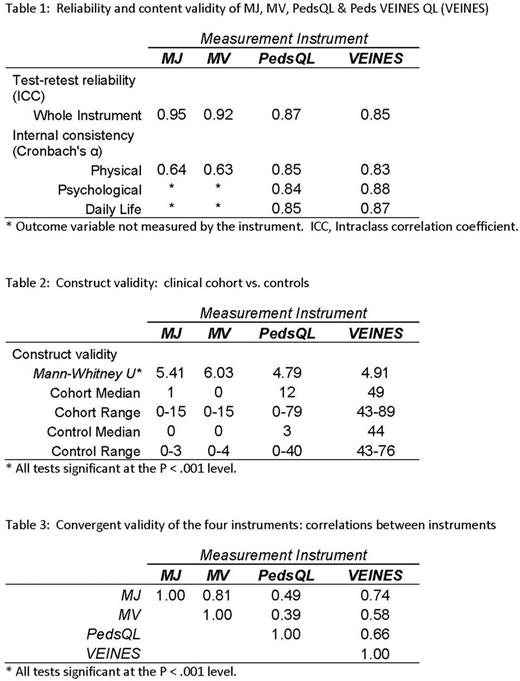Abstract
Background: The sharply increasing rate of venous thrombotic events (VTE) in children makes the development and validation of outcome instruments critical for future research and care. To date, there are insufficient validated tools to assess children following VTE. This has resulted in widely varied reported rates of post thrombotic syndrome (PTS) in children ranging from 10 to 70%, and a poor understanding of quality of life (QoL) outcomes in children following VTE.
Methods: A clinical cohort of 85 children < 21 years of age with a history of VTE and 60 healthy pediatric controls from three tertiary care thrombosis clinics were enrolled in a consented, non-interventional study of PTS outcomes. All cases and controls were assessed using two previously published pediatric PTS scales (Manco-Johnson (MJ) and Modified Villalta (MV)), a generic pediatric health-related QoL scale (PedsQL) and a new venous specific QoL scale derived from a validated adult scale (Peds VEINES QL) [Goldenberg, Haematologica 2010; Kahn JTH 2006; Kahn J Clin Epidemiol 2006]. Forty-nine of the original cohort were assessed again by a second examiner 2 to 4 weeks later. Inter-rater reliability, test-retest reliability, content validity, construct validity, and convergent validity were assessed for each measurement instrument.
Results: Using the MJ scale, 18.8% of children demonstrated physical signs of PTS with concomitant pain limiting participation. Using the MV 50.6% had mild PTS, 5.9% moderate and 1.2% severe. Pain was not a required element for any level of severity in the MV. The reliability and internal validity of all four measurement instruments was confirmed with standard psychometric tests (Table 1). All four instruments had high construct validity, with significant differences in outcomes between controls and the clinical VTE cohort (Table 2). Convergent validity was also confirmed with significant correlations between all four instruments (Table 3).
Discussion: All four instruments demonstrated strong reliability between raters and over time. All four had high discriminability for children with PTS relative to healthy controls. The MJ instrument identified a functional outcome of pain limiting participation along with physical findings. The proportion of the VTE population positive for PTS using the MJ instrument was closer to the reported pediatric weighted mean [Goldenberg, above]. The MV identified some PTS in a majority of children following a VTE episode while not discriminating functional outcomes. Additionally, while all four instruments were significantly correlated with each other, the newly created Peds VEINES QL had higher convergent validity than the more general PedsQL. This indicates that the new PTS specific QoL scale provides a more accurate representation of the impact of PTS on QoL than more generic pediatric QoL scales.
Brandao: Boehringer Ingelheim: Consultancy, Research Funding.
Author notes
Asterisk with author names denotes non-ASH members.


This feature is available to Subscribers Only
Sign In or Create an Account Close Modal